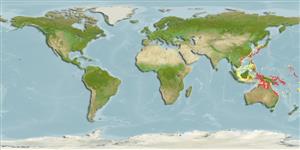>
Eupercaria/misc (Various families in series Eupercaria) >
Lethrinidae (Emperors or scavengers) > Monotaxinae
Etymology: Gymnocranius: Greek, gymnos = naked + Greek, kranion = skull (Ref. 45335); satoi: Named for Torao Sato, a Japanese ichthyologist..
Environment: milieu / climate zone / depth range / distribution range
Ecologie
marien; diepte 20 - 40 m (Ref. 107926). Tropical
Verspreiding
Landen | FAO regio's | Ecosystemen | Voorkomen | Point map | Introducties | Faunafri
Western Pacific: New Caledonia, West Papua (Raja Ampat), southern Japan and possibly Australia (GBR), the Solomon Sea, Bismarck Sea and New Guinea.
Grootte / Gewicht / Leeftijd
Maturity: Lm ? range ? - ? cm
Max length : 42.2 cm SL mannelijk / geslacht onbekend; (Ref. 107926)
Korte beschrijving
Morfologie | Morfometrie
This high-bodied species is distinguished by the following characters: ratio of standard length to body depth between 2.39 and 2.45; bumpy forehead; the lower edge of eye well above axis of body; caudal fin is shallowly forked, the lobes convex on inner side; scale rows above lateral line 6; pored scales on lateral line 47-50; flanks silvery; scales above the lateral line possess a dark-grey basal patch forming longitudinal rows; scales in the three rows below lateral line in middle of flank also forming darker rows, but basal patch not as dark as above lateral line; snout an cheeks with blue speckles against bronze background, distinctive on fresh and larger individuals, but faint on smaller individuals; blue band joining the nostrils on forehead; the area immediately above eye (supraorbital shelf) forming a distinctive brownish to blackish eyebrow; more or less conspicuous vertical dark bar crossing the eye; dorsal, pectoral, anal and caudal fins are reddish to bright vermilion red; upper lip is reddish to red while the lower lip white (Ref. 107926).
This species apparently lives on the coral sandy bottom in the vicinity of coral reefs (Ref. 107926).
Levenscyclus en paargedrag
Maturiteit | Voortplanting | Paaien | Eieren | Fecunditeit | Larven
Borsa, P., P. Béarez, S. Paijo and W.-J. Chen, 2013. Gymnocranius superciliosus and Gymnocranius satoi, two new large-eye breams (Sparoidea: Lethrinidae) from the Coral Sea and adjacent regions. Comptes Rendus Biologies 336: 233-240. (Ref. 107926)
Status op de Rode Lijst van het IUCN (Ref. 130435)
Gevaar voor de mens
Harmless
Gebruik door de mens
Meer informatie
LandenFAO regio'sEcosystemenVoorkomenIntroductiesStocksEcologieDieetVoedselitemsVoedselconsumptieRantsoen
Lokale namenSynoniemenMetabolismePredatorenEcotoxicologieVoortplantingMaturiteitPaaienPaaiaggregatiesFecunditeitEierenOntwikkeling van de eieren
Leeftijd/GrootteGroeiLengte-gewichtLengte-lengteLengtefrequentiesMorfometrieMorfologieLarvenLarvale populatiedynamiekRekruteringAbundantieBRUVS
ReferentiesAquacultuurAquacultuurprofielKweeklijnenGeneticaElectrophoresesErfelijkheidZiektesVerwerkingNutrientsMassaconversie
Tools
Speciale rapporten
Download XML
Internetbronnen
Estimates based on models
Fylogenetische diversiteitsindex (Ref.
82804): PD
50 = 0.5010 [Uniqueness, from 0.5 = low to 2.0 = high].
Bayesian length-weight: a=0.01778 (0.00761 - 0.04154), b=2.97 (2.78 - 3.16), in cm total length, based on LWR estimates for this (Sub)family-body shape (Ref.
93245).
Trofisch niveau (Ref.
69278): 3.4 ±0.6 se; based on size and trophs of closest relatives
Weerstandsvermogen (Ref.
120179): Gemiddeld, minimale populatieverdubbelingstijd 1,4-4,4 jaar (Preliminary K or Fecundity.).
Fishing Vulnerability (Ref.
59153): Moderate vulnerability (41 of 100).
